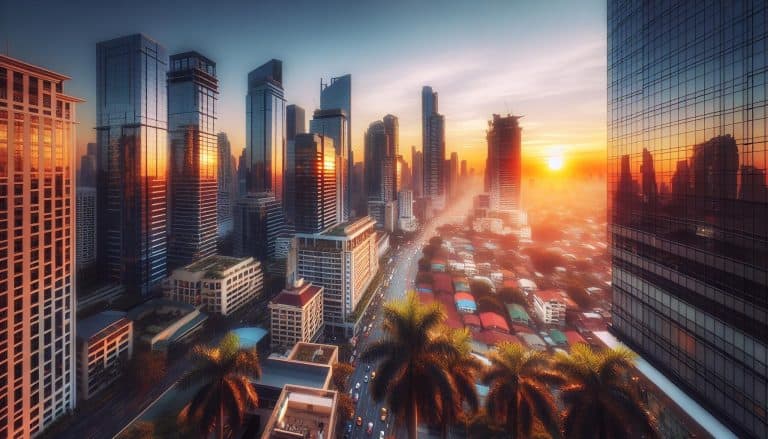Digital Nomad Philippines: Ultimate 2025 Guide

Are you dreaming of working from a tropical paradise?
Southeast Asian is increasingly attracting Digital Nomads and The Philippines is one such place that is rapidly turning into a hotspot for Digital Nomads.
Its has amazing beaches, lively culture, very affordable living compared to the west and all while experiencing the renowned Filipino hospitality.
Whether you’re a freelancer or a remote worker, this guide will assist you in navigating all you need to know about Digital Nomad Philippines as far as living and succeeding in this lovely archipelago is concerned.
Key Takeaways
- Cost of Living: Expect $800 to $1,500 monthly, give or take, depending on your lifestyle.
- Key Locations: Cebu, Manila, and Siargao: Solid internet, coworking, and lively vibes.
- Local Culture: Say “please” and “thank you,” and embrace the Filipinos’ warm nature. It goes a long way.
- Lifestyle Perks: Beautiful landscapes, tasty eats, and easy weekend getaways. A good work/fun balance.
Visa Watch: - Keep an eye out: a digital nomad visa might be coming, making longer stays simpler.
Why the Philippines is a Top Destination for Digital Nomads
The Philippines is fast turning into a top place for digital nomads searching for a blend of excitement, low costs, and a friendly crowd.
It highlights an affordable way of life, stunning views, and a increase in the remote job scene, it’s no shock that more freelancers & online workers are picking this island paradise as their home.
Affordable Cost of Living
One big reason why digital nomads enjoy the Philippines is because it’s cheap.
Compared to other well-known nomad spots like Bali & Thailand, living costs here stay pretty low.
You could rent a nice apartment in places like Cebu or Davao for just $300 to $500 each month.
Food is also easy on the wallet. A dish at a nearby diner (known as a Carinderia) costs about $2 to $3, while eating at a mid-level restaurant could cost you $10 and $15.
Getting around is affordable too—ride-hailing services like Grab help you travel without using up all your cash.
Tropical Climate and Stunning Landscapes
If you enjoy hot weather & stunning shores, the Philippines is great for you. With more than 7,000 islands, you won’t ever get bored of spots to check out.
Famous places like Siargao, Palawan, and Boracay have super clear water, soft white sand, and a chill island feel.
For folks who like mountains & chilly weather, Baguio and Sagada offer a cool getaway.
Whether you enjoy riding waves, snorkeling, or trekking, the Philippines gives something for each nature lover.
Growing Digital Nomad Community
The digital nomad lifestyle in the Philippines is expanding quickly.
Places like Cebu, Manila & Siargao have more coworking hubs, meetups, and foreigner-friendly coffee shops with steady Wi-Fi.
Platforms such as Nomadic Southeast Asia offer useful info, including advice on top coworking spots, visa choices, and money-saving ideas.
Other groups like Facebook communities for remote workers in the Philippines are awesome for finding similar people & getting local tips.
With its low cost, stunning nature, & friendly people, the Philippines is a perfect spot for digital nomads searching for a new and thrilling place to do remote work.
Best Cities in the Philippines for Digital Nomads
The Philippines has a blend of busy cities & relaxed islands, making it an awesome place for digital nomads with various ways of living.
Whether you like a quick-moving city life or a peaceful coastal town, there’s a place for you!
Here are the best cities for remote workers in the Philippines.
Manila: The Business Hub
If you want a town with solid roads, quick Wi-Fi, & lots of chances to meet people, Manila is where you should go.
Since it’s the main city, it has big companies, shared offices, and an expanding new business community.
- Top shared offices: Look into WeWork Manila & KMC Solutions for steady Wi-Fi and a good workspace.
- Where to stay: Makati & BGC (Bonifacio Global City) are the top spots for remote workers, with up-to-date apartments, coffee shops, and simple access to shared workspaces.
- Getting around: Use Grab for hassle-free transportation, as public transport can be chaotic.
Manila is ideal for nomads who need a business-friendly environment with all the conveniences of a big city.
Cebu: A Balance of Work and Leisure
Cebu is an awesome blend of city energy & island feel. It has a solid foreigner community, steady WiFi, and lots of shared work areas, while also being near stunning shores and nature places.
- Best coworking spaces: The Company Cebu and ASPACE Cebu offer great workspaces with a friendly community.
- Where to stay: IT Park & Lahug are top spots for remote workers, with new apartments, cafes, and shared workspaces close by.
- Things to do: On weekends, take a short trip to Moalboal for snorkeling or Oslob to see whale sharks.
Cebu is perfect for digital nomads who want a balance between work and adventure.
Siargao: A Paradise for Remote Workers
If you imagine having a job from a warm island, Siargao is the spot to go.
Called the surfing hub of the Philippines, it has a chill atmosphere, amazing shores, and a rising remote worker crowd.
- Top coworking spots: Nomad’s Hub Siargao & Lokal Siargao provide solid internet and a chill place to work.
- Where to stay: General Luna is the main spot for remote workers, with lots of hostels, hotels, and cafes with internet.
- Things to do: When you’re not working, go island hopping, surf at Cloud 9, or explore the Sugba Lagoon.
Siargao is ideal for nomads who want a slower pace of life while staying connected to work.
For extra details on the top places for Digital Nomads in Southeast Asia, visit Nomadic Southeast Asia, which gives thorough guides on shared workspaces, living expenses, & visa choices.
Internet Connectivity and Coworking Spaces in the Philippines

Staying online is super important for digital nomads, and even though the Philippines has made its internet better, speeds still change based on where you are.
Whether you want a steady home connection, a shared workspace, or a coffee shop with good Wi-Fi, here’s what you should know.
Best Internet Providers and Mobile Data Options
If you’re living there for a while, having a fiber internet setup is the smartest choice. The best companies in the Philippines include:
- PLDT Home Fiber – Offers the most stable connection, with speeds up to 1 Gbps in major cities.
- Globe At Home – Another solid option, especially in Metro Manila and Cebu.
- Converge ICT – Known for its affordable fiber plans with decent speeds.
For cell data, Globe & Smart are the top two suppliers.
If you want a wireless internet option, think about grabbing a portable Wi-Fi or an eSIM from companies such as Airalo and Nomad eSIM for smooth connection.
Top Coworking Spaces in the Philippines
Coworking spaces are growing in popularity, especially in major cities. Here are some of the best options:
- WeWork Manila – A premium coworking space with multiple locations in the capital.
- The Company Cebu – A modern workspace with a strong digital nomad community.
- Nomadwise’s Hub Siargao – A great spot for remote workers looking for a relaxed island vibe.
For a complete list of the top shared workspaces in Southeast Asia, take a look at Nomadic Southeast Asia, which gives in-depth feedback & suggestions.
Cafés with Reliable Wi-Fi for Remote Work
If you prefer working from a café, here are some great options with strong Wi-Fi:
- Toby’s Estate (Manila, Cebu) – A popular café chain with great coffee and fast internet.
- Commune (Makati) – A cozy spot with a digital nomad-friendly atmosphere.
- Shaka Café (Siargao, Cebu) – A beachfront café with good Wi-Fi and healthy food options.
While web speeds in the Philippines might be unreliable, picking the best company, shared office, or coffee shop could make working remotely way easier.
Visa and Legal Requirements for Digital Nomads
If you’re thinking about working remotely in the Philippines, knowing visa choices & legal rules is important.
Though the nation is friendly to visitors, staying long-term needs some preparation. Here’s what you should understand.
Tourist Visa vs. Long-Term Stay Options
Most digital nomads looking for visa options, checkout the Philippines Visa Online Portal is a good source to help you get your tourist visa, which is easy to obtain:
- No-visa entry (aka visa on arrival): People from lots of nations, like the U.S., Canada & most of Europe, may remain for 30 days with no visa.
- Tourist visa extension: You may lengthen your visit for as long as 36 months by updating your visa every month or two at the Immigration Office.
For those looking for a more stable option, consider:
- Special Resident Retiree’s Visa (SRRV) – Though made for retirees, it lets people stay long-term with a money investment.
- Work Visa or Business Visa – If you want to open a company or be employed by a nearby business, these are worth looking into.
Philippines Digital Nomad Visa: What We Know So Far
As of 2025, the Philippines has been thinking about a remote worker visa aka Digital Nomad Visa, kinda like the ones in Thailand & Indonesia.
Even though no real program has started yet, watch for news from Nomadic Southeast Asia, which follows visa updates all over the area.
If introduced, a digital nomad visa would likely:
- Allow remote workers to stay for 6-12 months
- Require proof of income or remote employment
- Offer tax benefits for non-resident workers
Essential Legal Considerations for Remote Workers
Even if you’re working remotely for a foreign company, it’s important to stay compliant with local laws:
- Taxes: The Philippines doesn’t charge taxes on money earned in other countries unless you sign up as a local taxpayer. But, talk to a tax expert to make sure you follow the rules.
- Business Sign-Up: If you want to work for nearby customers, you might have to sign up as a solo worker.
- Banking and Payments: Tools such as Wise & Payoneer help you get paid while skipping big charges.
For the newest visa news & legal advice, Nomadic Southeast Asia gives detailed guides on keeping legally safe while doing remote work in the Philippines.
The Philippines: Cost of Living and Budgeting Tips

The Philippines is among the cheapest places for remote workers, giving a good lifestyle without costing too much.
Whether you’re living in a large city or a coastal town, here’s what you should understand about managing costs and keeping cash.
Average Monthly Expenses for Digital Nomads
Your living expenses in the Philippines will vary based on how you live & where you live. Below’s an approximate breakdown of monthly expenses..
- Housing: $300 – $800 (budget apartments to high-end condos)
- Food: $200 – $400 (local eateries vs. dining out at restaurants)
- Coworking Space: $100 – $200 (optional, depending on your work setup)
- Transportation: $50 – $150 (Grab rides, public transport, or renting a scooter)
- Internet & Mobile Data: $30 – $60 (fiber internet + mobile plan)
- Entertainment & Activities: $100 – $300 (weekend trips, nightlife, and hobbies)
On average, a remote worker can comfortably survive in the Philippines for $1,000 to $1,500 per month, though some get by on even less.
Best Budget-Friendly Accommodations
Economical accommodation is readily available, especially if you know where to look:
- Airbnb – Great for short-term stays, with discounts for monthly rentals.
- Facebook Marketplace & Expat Groups – Landlords usually list apartments here at lower prices than Airbnb.
- Hostels and Shared Living Spaces – Great for socializing with other travelers while saving money. Look into Selina Manila or Mad Monkey Cebu.
Money-Saving Tips for Living in the Philippines
- Eat like a local – Street food or you eat at Carinderias (local eateries) offer meals for as little as $2.
- Use public transport – Tricycles, buses, and Jeepneys cost much less than taxis or Grab
- Negotiate rent – If staying long-term, landlords often lower prices for 3+ month stays.
- Get a local SIM card – Globe and Smart have low-cost data plans, which avoid roaming charges.
- Join expat & digital nomad communities – Groups will share inside info on bargains, discounts, and money-saving tricks.
With smart budgeting, you can enjoy an amazing lifestyle in the Philippines without overspending.
Learning Filipino Culture and Etiquette
Filipinos are famous for their kindness & warmth, making it simple for remote workers to feel welcome. Here’s some cultural advice to remember:
- Respect personal space – Although Filipinos are hospitable and welcoming, they are also polite and respectful.
- Use “po” and “opo” – They show respect when addressing elders or those who are in a place of authority.
- Be patient – Things move at a slower pace, especially in government agencies and public transportation.
- Smile often – A smile gets a long way in the Philippines, whether meeting new people or asking for help.
For extra cultural knowledge, Wandering Southeast Asia gives tips on fitting into life in various Southeast Asian nations.
Must-Try Filipino Dishes and Street Food
Filipino cooking is a blend of Spanish, Chinese & native flavors, making a special and tasty food culture.
Here’s a few dishes you gotta try:
- Adobo – A tasty dish made of chicken or pork, marinated in soy sauce, vinegar, and garlic.
- Sinigang – A sour tamarind soup with pork, shrimp, or fish.
- Lechon – A roasted whole pig, usually served during celebrations.
- Balut – A fertilized duck egg, a popular street food for the daredevil eater.
- Halo-Halo – A cool dessert consisting of crushed ice, sweet beans, fruits, and ice cream.
For the ultimate street food experience, go to Mercato Centrale in Manila or Larsian BBQ in Cebu.
Best Weekend Getaways for Digital Nomads
The Philippines is full of amazing places to explore on your days off. Here are some of the best weekend trips:
- Siargao – A laid-back island perfect for surfing and beachside remote work. 🏄
- Palawan – El Nido and Coron are known for their stunning lagoons and island-hopping tours.
- Baguio – A windy mountain retreat with charming views and cozy cafes.
- La Union – A surf town just a few hours from Manila, great for a quick escape.🏄
- Bohol – Famous for the Chocolate Hills and beautiful white-sand beaches.
By keeping an open mind and embracing the traditions, tasting regional meals, & discovering fresh locations, you’ll get the best out of your Digital Nomad Philippines adventure.
Final Thoughts
The Philippines is an amazing place for digital nomads, giving a great mix of low costs, stunning scenery, & an expanding remote work scene.
Whether you like the busy vibe of Manila, the relaxed feel of Cebu, or the tropical beauty of Siargao, there’s a place for every type of remote worker.
Reliable web, shared offices, and a friendly vibe make it simpler than ever to stay & work here.
Also, with visa choices changing, sticking around long-term is getting more doable.
Money-saving travelers will like the cheap cost of life, while thrill-seekers will enjoy the never-ending chances for discovery.
If you’re really into making Southeast Asia Your Second Home as or Exploring to become a Digital Nomad, Nomadic Southeast Asia is has awesome guides to help you through this adventure.
From travel advice & expat tricks to detailed steps on making money from what you love, it’s full of all you need to succeed as a remote worker in the area.
So, what’s coming?
Begin organizing your relocation, look into the top place for your way of life, & link up with other travelers. The
Philippines is ready for you—why not make 2025 the time you go for it. 🌏💻
Frequently Asked Questions (FAQs)
Which Philippine city is most ideal for digital nomads?
While it varies on individual choice, Cebu and Siargao are often mentioned as the top choices. Cebu has both urban life and lovely beaches, while Siargao is for those who love surfing and a relaxed atmosphere.
How costly is life as a digital nomad in the Philippines?
For an average of $800 to $1,500 per month, depending on life style, digital nomads can get by. This covers accommodations, meals, transportation, and leisure activities, which is a very acceptable option for most Western nations.
Is the internet reliable for remote work in the Philippines?
Yes, the majority of towns, particularly Manila and Cebu, have stable internet connections. Coworking areas and cafes usually offer fast Wi-Fi, but it never hurts to have a backup mobile data plan, just in case.
Do I need a visa to work remotely in the Philippines?
If you’re just looking to stay briefly, a tourist visa should normally be adequate. But if you’re looking at longer-term stays, then possibilities like the new Digital Nomad Visa could be an option. Always review current regulations before your visit.
Some cultural tips for digital nomads in the Philippines?
Filipinos are friendly and warm. It is courteous to smile and greet others with simple Filipino words like “Salamat” (Thanks). Being aware of local customs will make your stay worthwhile and enable you to connect with the people.


